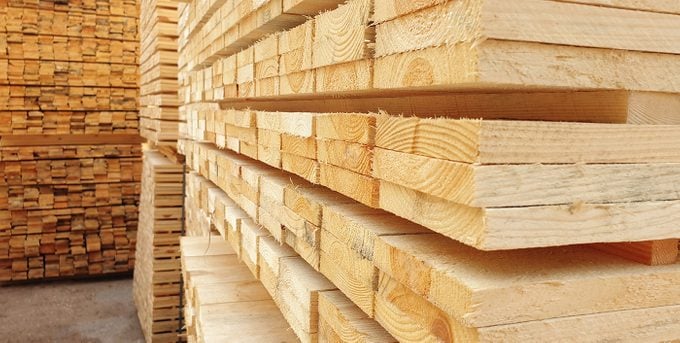The Real Reason It’s So Hard to Buy New Home Appliances Right Now

From refrigerators to bikes to lumber, the pandemic has driven demand and interrupted supply chains.
Remember when the pandemic first hit, and toilet paper was sold out everywhere? Now, more than a year later, the list of retail shortages is longer—and more unpredictable.
Take bikes, for instance. If you’ve tried to buy one this spring, you’ve likely been told that there’s a lengthy wait list. How about lumber? Anyone planning on building a deck during the lockdown will have discovered the price of lumber has skyrocketed (if you actually managed to get your hands on the stuff, that is). What exactly is going on here? How many products are being affected, and when will these shortages end? Here’s what you need to know about the ongoing impact of the pandemic on Canadian retail.
What’s behind the shortages?
There are two main factors behind the current Canadian retail shortages: our new hobbies, and problems with the global supply chain.
“This tidal wave of changing demands has swept through retail around the world,” says Michael LeBlanc, a senior adviser for the Retail Council of Canada. In short, manufacturers are having a hard time keeping up with pandemic hobby-induced demand. Last spring, kitchen tools like bread makers and espresso machines were sold out everywhere. Now, it’s outdoor goods and construction materials.
The supply chain issues that are currently plaguing the retail world are multifaceted. The companies behind your favourite goods typically plan their supply years in advance, and those plans obviously didn’t factor in a global health crisis of this scale. What’s more, when the pandemic hit last spring, a lot of businesses decided to cancel their normal orders in an attempt to save money, “And the supply chain is harder to start than it is to stop,” says LeBlanc. Compounding these issues, manufacturers and shippers have spent the past year working under COVID-19 restrictions, which means fewer staff are available to work.
The supply chain itself isn’t functioning at its pre-pandemic efficiency thanks to overcrowded seaways (LeBlanc says there have never been so many boats on the water) and air travel restrictions. Typically, 45 to 50 per cent of all air cargo is transported in passenger planes. Fewer intercontinental flights mean there’s less opportunity for cargo to hitch a ride with passengers. Then, there are the shortages and skyrocketing prices on the necessary tools for transportation, including boxes and pallets. “The cost of pallets has gone up 400 per cent,” says LeBlanc. “It’s the most congested and most expensive it has ever been in history to get your cargo on a boat.”

What products are affected in Canada?
According to LeBlanc, products that extend your time outdoors (think: bikes, patio furniture and gardening materials) are all in shorter supply. Consumers will have to shop harder to find exactly what they’re looking for, and may have to settle for a different brand or model than they’d envisioned—or at the very least, pay a lot more for it.
Microchips, like the semiconductors that are found in cars, are also facing a shortage. “More TVs, more computers, more electronics in general [are in demand] because more people working and learning at home,” says LeBlanc. Unfortunately, microchips are in a large variety of electronics we use every day, from laptops to smartphones to washing machines—meaning that if you’re in the market for any of those items, you might be out of luck for months.
Likewise, lumber is difficult to source—and prohibitively expensive. In March 2020, two-by-fours cost between $500 and $600 per thousand board feet; now, you can expect to pay about $1,400 for the same amount. The shortage in lumber is due in part to the wood mills shutting down earlier in the pandemic, and the resulting difficulties in starting them back up again, says LeBlanc. Construction materials like screws and nails are also hard to come by at the moment, as many house-bound Canadians have been using the pandemic to tackle do-it-yourself projects and home improvements.

How long will these shortages last?
The biggest indicator of things getting back to normal is the vaccine rollout. LeBlanc points to rising second-dose rates and schools reopening in September as signs that things might stabilize soon. “Demand will start to moderate as the world returns to normal,” he says. “If we’re in good shape with lots of immunity, then we can start opening up and have a real holiday [shopping] season.”
As conditions stabilize, supply chains will catch up with demands. LeBlanc points to the toilet paper rush of the early pandemic as an example of how this might work out. That demand was driven by the fact that the existing toilet paper supply was in the wrong place (i.e., in empty workplaces). Once the industry was able to recalibrate, supply shifted to retail stores to keep up with the new at-home demand.
What does the future hold for shortages?
Just as the pandemic brought lifestyle changes that translated to a run on certain goods, the end of the pandemic might also mean new shortages on things like fashion and makeup. “As life returns to normal, you’re going to see these waves of demand,” says LeBlanc. “These demands reflect changes in our lives.”
Next, find out why Canadian butter isn’t as soft as it used to be.






